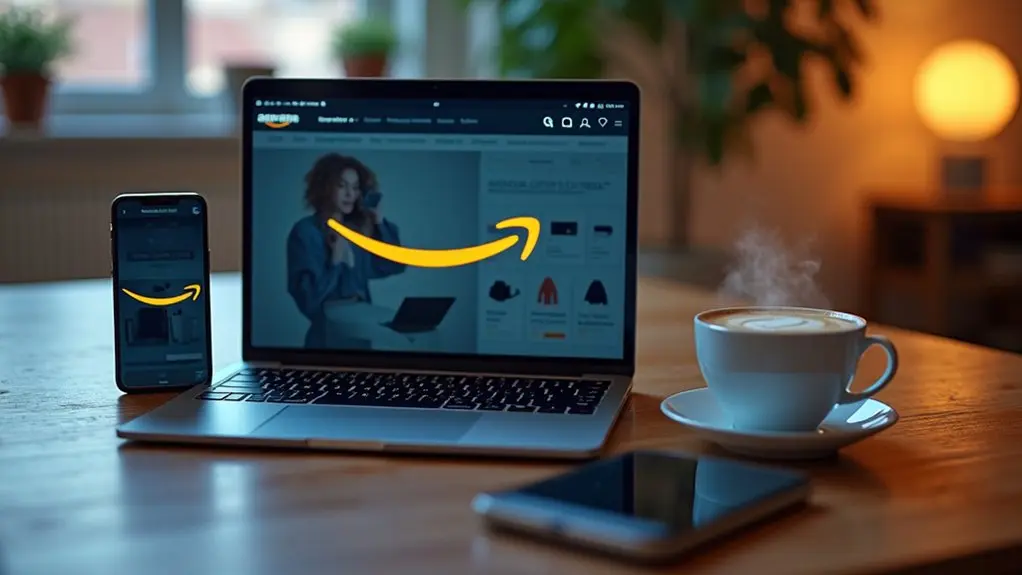To obtain an Amazon Storefront, applicants must first build a strong social media presence with significant engagement, as eligibility depends on public influence metrics. The process requires signing up with an eligible Amazon account, connecting a qualifying social media account, and awaiting approval. Upon acceptance, users can customize their storefront by uploading branding visuals and organizing curated product collections. Strategic promotion and storefront optimization impact earnings. For a detailed breakdown of setup and advanced optimization, further information follows.
Key Takeaways
- Ensure you have a public social media account with strong engagement on platforms like Instagram, YouTube, TikTok, or Facebook.
- Sign up for the Amazon Influencer Program using your eligible Amazon account.
- Connect your qualifying social media profile during the application process for eligibility verification.
- Await Amazon’s approval, then complete your storefront profile by customizing design elements and branding.
- Curate and organize products into collections, then promote your unique storefront link across your social channels.
Understanding the Amazon Storefront Opportunity
The Amazon Storefront opportunity presents a structured pathway for influencers to monetize their online presence through curated product recommendations.
Amazon Storefronts offer influencers a streamlined way to earn income by sharing personally curated product selections with their audience.
By participating in the Amazon Influencer Program, individuals with significant influence and high engagement metrics can establish a customized storefront. This storefront, accessible via a unique URL, allows influencers to categorize and display their preferred products efficiently.
Influencers can further customize storefronts with tailored titles, taglines, and images to optimize user experience and navigation. Earnings are generated through commissions on sales, with rates varying by product category, offering substantial income potential tied directly to effective promotion.
Promoting the storefront across high-traffic social media channels and consistently delivering quality content are critical, as these tactics drive increased traffic and maximize both conversions and overall revenue generation.
Eligibility Criteria for an Amazon Storefront
Eligibility for an Amazon Storefront hinges on measurable social influence and engagement across major platforms such as Instagram, YouTube, TikTok, or Facebook.
Applicants must possess a public social media account that demonstrates significant influence, as assessed through engagement metrics like likes, comments, and shares.
While the Amazon Influencer Program does not mandate a specific follower threshold, a higher follower count and consistent, high-quality content within a targeted niche directly impact eligibility determination.
The process to obtain an Amazon Storefront requires candidates to apply through the Amazon Influencer Program homepage, where they must connect their chosen social media accounts.
Amazon then evaluates the influencer profile, focusing on the applicant’s ability to drive engagement and maintain a public presence, ensuring alignment with program standards.
Choosing Between Influencer and Affiliate Storefronts
When selecting between Amazon Influencer and Affiliate Storefronts, users must assess eligibility requirements, which differ regarding social media presence and account criteria.
Analysis of earnings potential and commission structures reveals distinct advantages for each model, influenced by engagement levels and product categories.
Additionally, branding and promotion strategies should be tailored to the functionality and audience interaction provided by each storefront type.
Storefront Eligibility Requirements
Although both the Amazon Influencer and Affiliate programs facilitate product promotion, their storefront eligibility requirements differ markedly.
The Amazon Influencer Program mandates applicants possess a public social media account demonstrating substantial engagement, with eligibility for the Influencer Program hinging on engagement metrics such as likes and shares rather than a fixed follower threshold. High-quality content, typically within a specific niche, enhances approval prospects during the application process. Influencers must connect their social media accounts to verify engagement and content quality before they can create a storefront.
Conversely, Amazon Affiliates are required to have a website or app featuring original content but do not need significant social presence or engagement. Affiliates do not create unique storefronts; instead, they share product links and must generate three qualified sales within 180 days.
Earnings and Commission Structure
While both the Amazon Influencer and Affiliate programs provide opportunities to earn through product promotion, their commission structures and earning mechanisms differ markedly.
Amazon Influencers benefit from commission rates ranging from 1% to 10% per sale, with luxury beauty products offering the highest rates. Additionally, influencers can increase their earnings through onsite commissions, generated by shoppable content directly on Amazon. This setup, coupled with a personalized shopping experience via custom storefronts, can result in higher engagement and consequently potentially greater earning potential.
In comparison, Amazon Affiliates operate within a broader commission structure, earning between 1% and 20% per sale—Amazon Games being the highest. Reported average annual earnings for affiliates are $77,893, while influencers’ monthly earnings can reach $5,000, contingent on traffic and engagement.
Branding and Promotion Strategies
A significant distinction between Amazon Influencer and Affiliate storefronts lies in their approach to branding and promotion, directly impacting audience engagement and conversion rates.
Amazon Influencers can leverage custom URLs and a curated selection of products, enabling advanced branding and trust-building through strong audience engagement on social media channels. In contrast, affiliate storefronts prioritize user-friendly layouts with original content and broad product categories, relying on search-based traffic rather than direct audience interaction.
Promotion strategies should align with the target audience and content strengths. Influencers benefit from personalized branding and higher commissions, while affiliates can scale reach across multiple platforms without a dedicated following.
Key considerations include:
- Level of branding via custom URLs and curated selection
- Promotion strategies tailored to social media channels or web platforms
- Audience engagement versus traffic-driven approaches
Setting Up Your Social Media Presence
To qualify for an Amazon Storefront through the Amazon Influencer Program, establishing a robust social media presence is essential.
Prospective content creators should optimize their social media accounts on platforms such as Instagram, YouTube, TikTok, or Facebook. Cultivating a large following increases visibility and enhances eligibility for the program.
Optimizing social media profiles and growing your follower base boosts both your visibility and your chances of joining the Amazon Influencer Program.
The creation of engaging content aligned with a specific niche is vital, as it drives higher rates of interaction—likes, comments, and shares—which build trust with followers and signal influence to Amazon.
Consistent posting and audience interaction foster community loyalty, further improving engagement metrics.
Utilizing built-in analytics tools enables data-driven tracking of follower growth and content performance, allowing for continuous optimization of strategy.
These technical steps are foundational for those seeking to meet the Amazon Influencer Program’s expectations.
Applying for the Amazon Storefront Program
The initial step in applying for the Amazon Storefront Program involves maneuvering to the Amazon Influencer Program homepage and selecting “Sign up” using an existing Amazon customer or Associates account.
Prospective influencers must link a public social media account—such as Instagram, YouTube, TikTok, or Facebook—with substantial engagement to apply for the Amazon storefront. Approval times are data-driven: applications via YouTube or Facebook are typically instant, while Instagram and TikTok may require up to 5 days for assessment.
Upon approval, applicants must complete their profile by entering a storefront name and tagline to access the dashboard. To maximize earning potential, influencers should focus on unique product recommendations after profile completion.
The application workflow can be summarized as:
- Sign up with an eligible Amazon account
- Connect a qualifying social media account
- Await approval and complete the profile
Customizing and Designing Your Storefront
Customizing an Amazon storefront begins with consistent branding through visual elements such as header images, profile photos, and brand-specific page titles.
Structuring product collections into clearly defined categories optimizes user navigation and facilitates efficient product discovery.
Implementing these design strategies increases both storefront usability and alignment with the brand’s strategic objectives.
Branding With Visual Elements
When establishing an Amazon storefront, effective branding with visual elements requires a systematic approach to customization and design. Data suggests that the right visual strategy increases audience engagement and product visibility.
To maximize impact, sellers should:
- Upload a visually appealing header image reflecting brand identity and resonating with the target audience, ensuring all visual elements align for a cohesive aesthetic.
- Select a high-quality profile photo that represents the brand or individual, promoting trust and recognition among potential customers.
- Craft a concise page title and tagline encapsulating the niche and encouraging exploration of product recommendations.
Consistent updates to these elements maintain storefront freshness and relevance.
Strategically designed branding increases product listings’ discoverability, guiding the audience efficiently through the Amazon storefront and strengthening brand recognition over time.
Organizing Product Collections
Structuring product collections within an Amazon storefront demands a methodical approach that prioritizes user navigation and product discoverability. When sellers create an Amazon Storefront, organizing product collections by clear product category guarantees shoppers swiftly locate relevant items. Incorporating unique curated lists—such as exclusive product recommendations or themed seasonal collections—strengthens shopper engagement and satisfaction. A custom Amazon layout, complemented by a visually appealing header image, not only reinforces brand recognition but also enhances the overall shopping experience. Updating collections regularly with new products and timely recommendations encourages repeat visits and keeps content dynamic.
| Organization | Emotional Impact |
|---|---|
| Curated Lists | Sense of exclusivity |
| Seasonal Collections | Anticipation & excitement |
| Visual Branding | Trust & recognition |
Proper structure makes the storefront efficient, compelling, and brand-focused.
Enhancing Storefront Navigation
An effective Amazon storefront relies on meticulous navigation design, with product listings segmented into distinct, well-labeled categories to streamline user experience and accelerate product discovery.
Enhancing storefront navigation begins with a clear structure, allowing users to efficiently browse and identify relevant product recommendations. Incorporating engaging product descriptions and high-quality images strengthens user engagement, while a unique title and tagline reinforce brand identity.
Applying SEO best practices, such as integrating relevant keywords, further improves visibility in search results and helps attract a larger audience.
To optimize storefront navigation, sellers should:
- Categorize product listings logically, using clear labels and consistent organization.
- Employ compelling product recommendations paired with engaging product descriptions and visuals.
- Continuously update content and keywords to maintain relevance and maximize search visibility.
Adding and Organizing Products in Your Storefront
To efficiently add and organize products within an Amazon Influencer storefront, users leverage Amazon’s integrated tools to curate selections directly from its catalog by utilizing the “Add to Storefront” feature.
Adding products involves browsing Amazon products, selecting relevant items, and incorporating them into the storefront. Each product can be assigned a unique title and product description to enhance clarity and personalization, fostering user engagement.
Easily curate your storefront by selecting Amazon products, adding custom titles and descriptions to create a personalized, engaging shopping experience.
Users organize products into logical categories—such as seasonal recommendations or thematic collections—for streamlined navigation. The storefront link directs audiences to a well-structured interface, supporting ideal discovery.
Employing analytics tools enables data-driven assessment of product performance, facilitating ongoing enhancement for increased sales conversions. Regular updates with trending or seasonal items further boost relevancy and encourage repeat visits, ensuring storefront success.
Promoting Your Storefront for Maximum Traffic
Effective promotion of an Amazon storefront relies on a strategic, multi-channel approach that leverages both organic and direct traffic sources.
Promoting products begins with distributing the storefront link across diverse platforms, such as Instagram, TikTok, and YouTube, to maximize exposure and drive traffic.
Utilizing SEO strategies guarantees that both the Amazon storefront and related content are discoverable, drawing organic visitors through targeted keywords in descriptions and posts.
Consistently creating engaging content—such as reviews and tutorials—and updating the storefront with new recommendations fosters repeat visits.
Community interaction, including responding to comments and hosting giveaways, further amplifies reach and engagement.
- Share the storefront link on multiple social channels and through Amazon affiliate marketing.
- Implement SEO strategies in all content for discoverability.
- Update storefront and engage community for sustained repeat visits.
Tracking Performance and Optimizing Earnings
Maximizing earnings from an Amazon storefront demands rigorous performance tracking and data-driven optimization. Influencers should leverage the Amazon Influencer dashboard to systematically review sales data, enabling precise identification of high-performing products and the refinement of product recommendations.
Tracking performance is further enhanced by integrating Google Analytics, which provides insights into traffic sources, audience engagement, and conversion rates. Implementing A/B testing on storefront layouts or promotional strategies allows for empirical assessment of what optimizes earnings.
Integrate Google Analytics and A/B testing to uncover what drives audience engagement, conversions, and higher Amazon storefront earnings.
In addition, Helium 10’s Xray Tool delivers competitive intelligence and sales performance metrics, supporting informed product selection. Frequent content updates and refreshed product recommendations maintain audience engagement and storefront visibility, directly impacting conversion rates and commission growth.
Methodical analysis and iterative adjustments are central to long-term success.
Frequently Asked Questions
How to Get Accepted Into the Amazon Influencer Program?
Acceptance into the Amazon Influencer Program requires meeting influencer requirements, excelling in content creation, and demonstrating strong social media engagement. The application process evaluates marketing strategies, niche selection, engagement tips, brand partnerships, and income potential to identify qualified candidates.
How Do I Get Into My Amazon Storefront?
Accessing the Amazon Storefront involves logging into the influencer dashboard, proceeding with storefront setup, utilizing storefront customization and design tools, implementing storefront marketing strategies, monitoring storefront analytics, and engaging in storefront management for ongoing storefront promotion and optimization.
How Many Followers Do You Need to Join the Amazon Influencer Program?
Follower requirements for the Amazon Influencer Program are not fixed, but a follower count above 1,000 is advantageous. Building audience engagement, niche selection, content creation, and influencer marketing strategies greatly impact social media influence and program benefits eligibility.
How to Get Amazon Storefront in the UK?
Obtaining an Amazon storefront in the UK allows influencers to access storefront analytics tools, design storefront layout, create storefront content, and promote products. Utilizing social media, storefront marketing strategies, and audience engagement best practices maximizes Amazon storefront benefits and earnings.
Conclusion
In conclusion, establishing an Amazon Storefront involves a structured process, from meeting eligibility requirements to utilizing data-driven optimization strategies. By carefully selecting between Influencer and Affiliate programs, setting up a robust social media presence, and applying through Amazon’s official channels, users can access powerful merchandising tools. Ongoing customization, product organization, and targeted promotion are essential for maximizing storefront performance. Data tracking and regular analysis enable continuous improvement, ensuring long-term profitability and effective engagement within the Amazon ecosystem.




